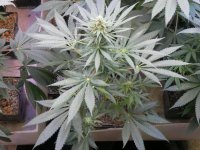All at once. Im going to estimate the 14 days before harvest date and change the photoperiod.
Perpetual still, just different rooms, for different cycles. So the lights run independently from the other rooms.
U will never know if u don't try, so why not. lol I have some respected, and experienced growers saying that it is effective, so its not like im going out on a limb risking much.
Seems legit, if it's just a portion of a bigger grow,
really nothing to lose. Also a one hour bump in hours
per day for a couple weeks overlaps flush time too.
Plants won't freak out while all that's going on.
Interesting. On topic and no bullshit.
Good stuff.







 , the 60 vs 90 days is especially interesting. Mahalo.
, the 60 vs 90 days is especially interesting. Mahalo.

